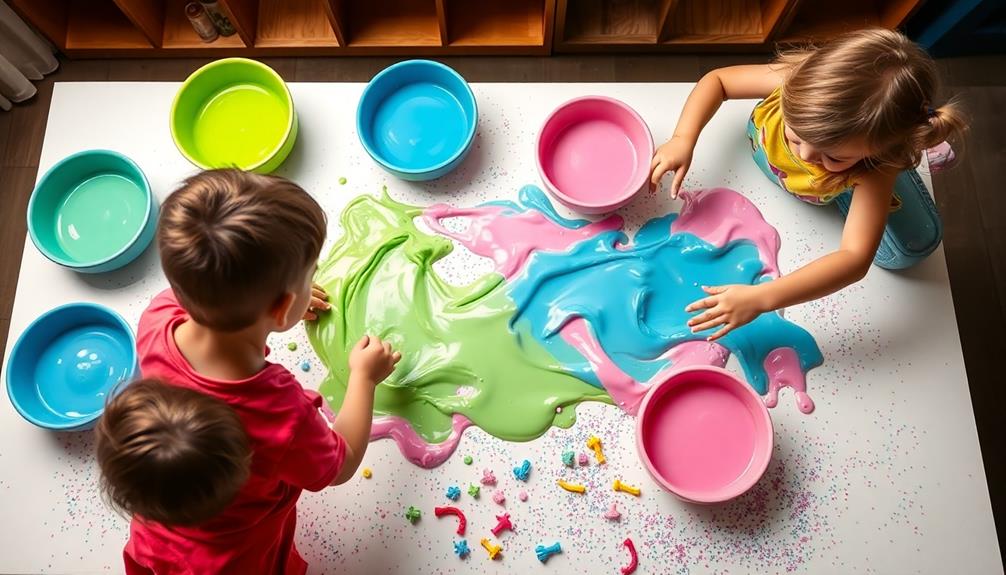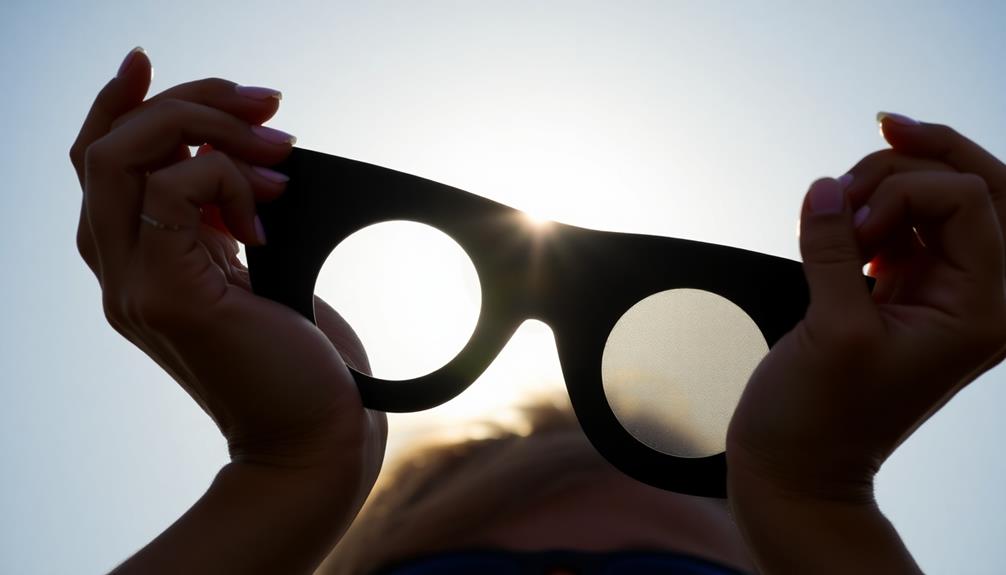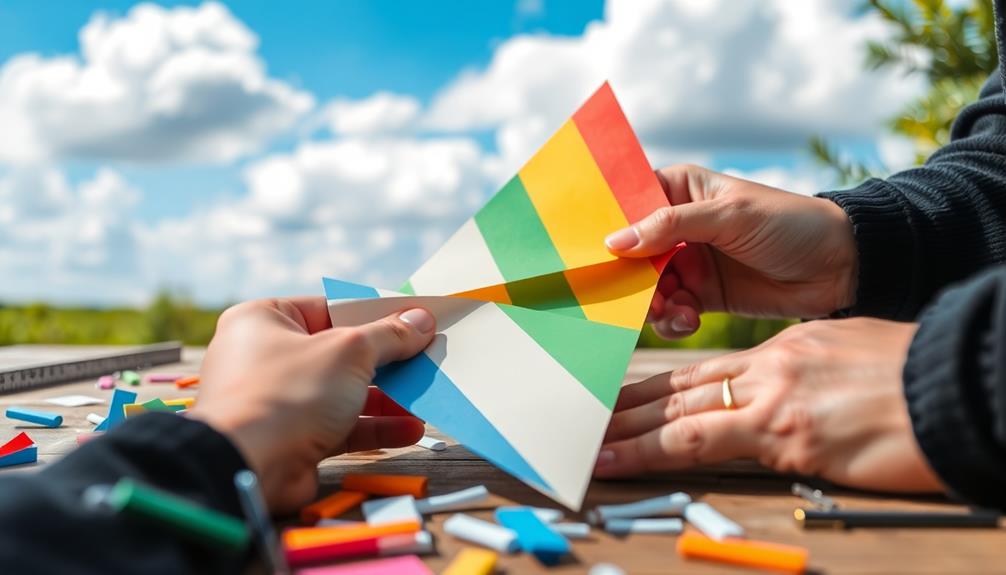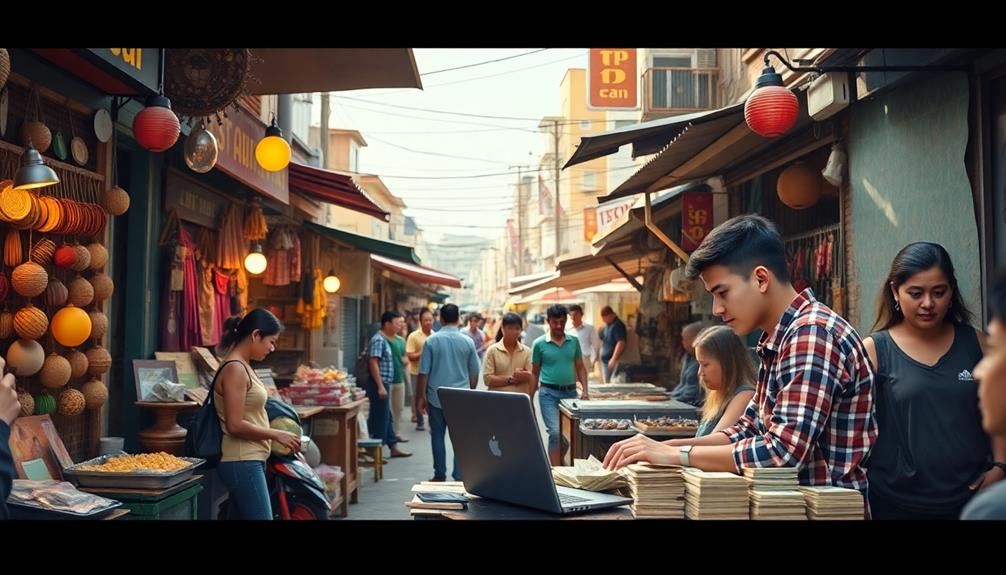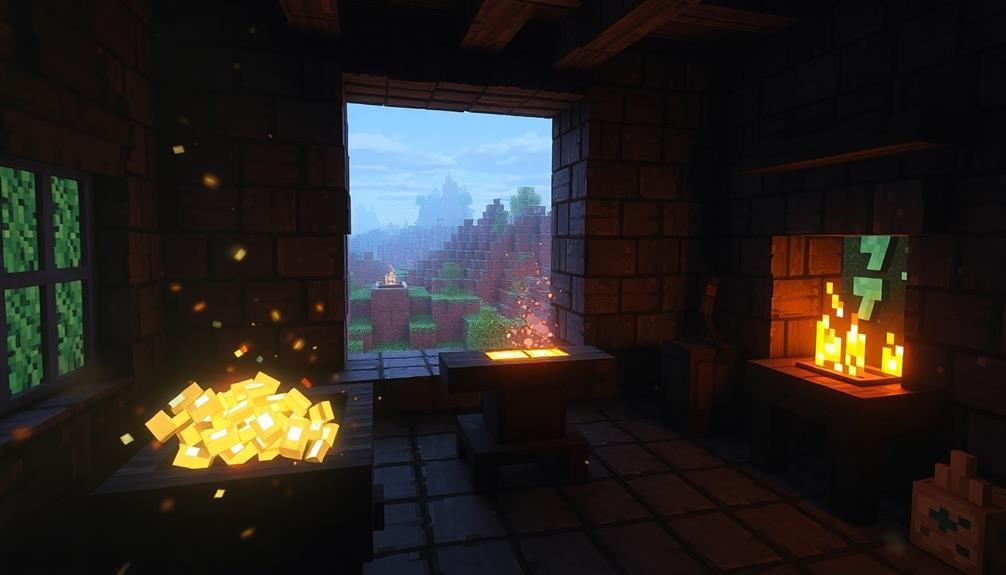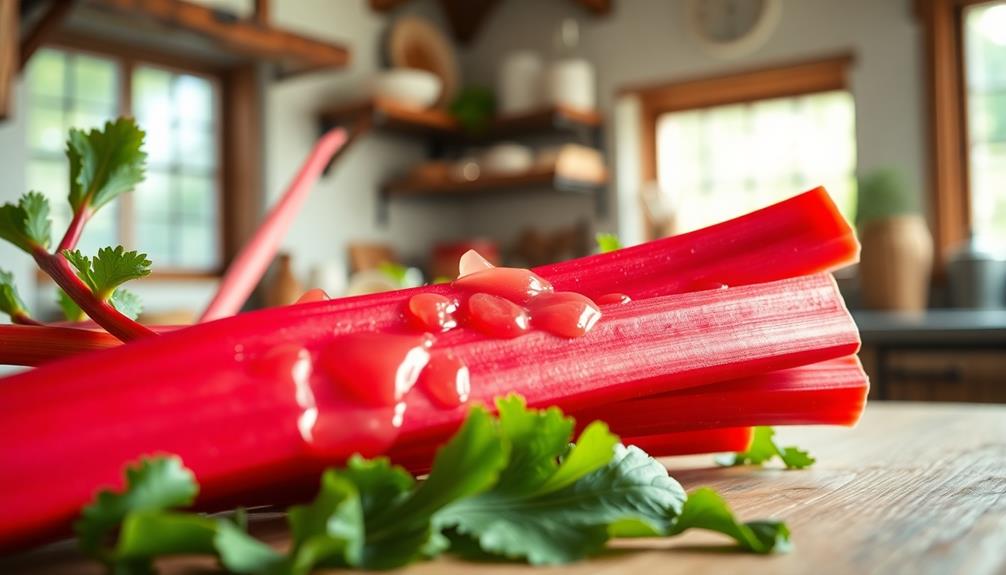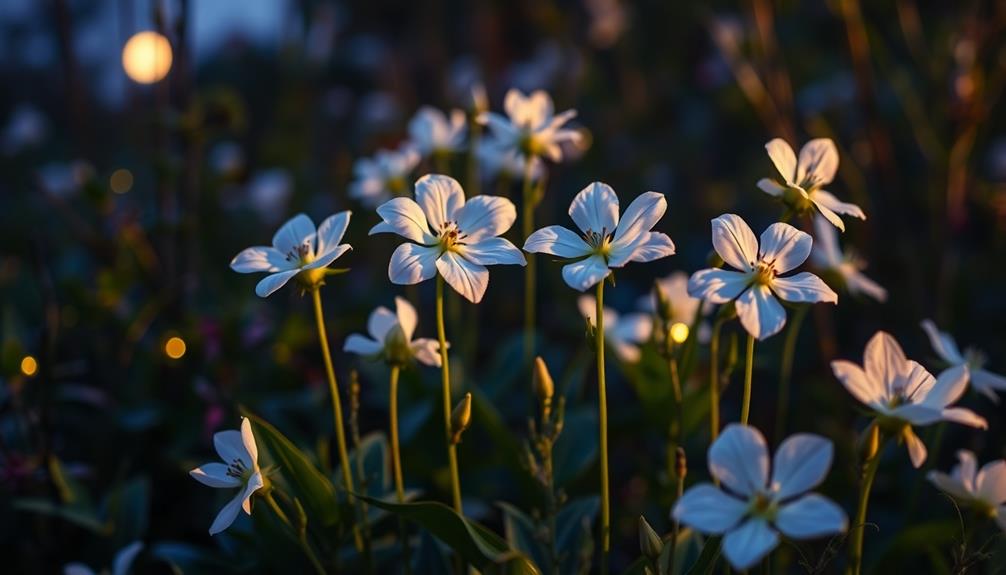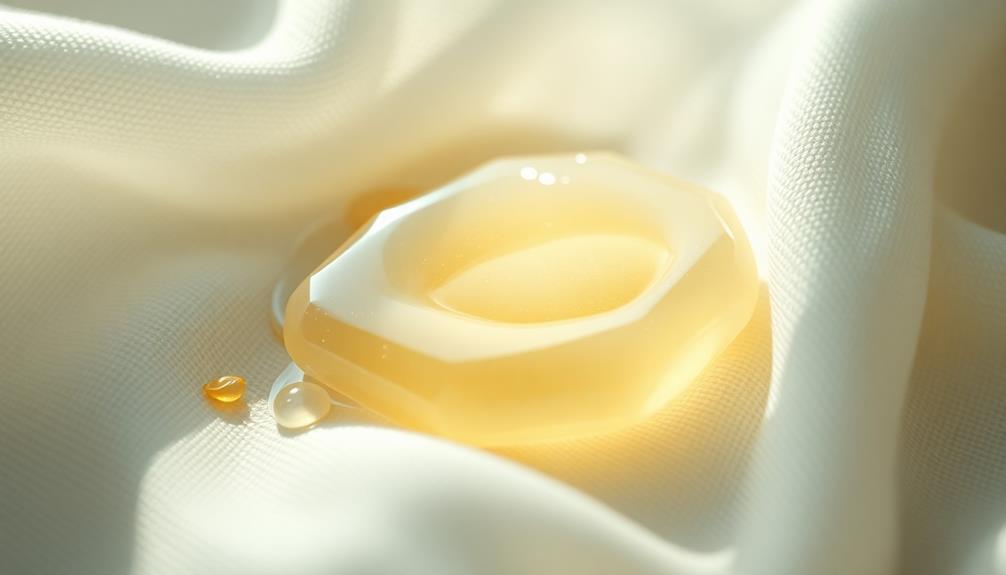To make fun Oobleck for kids, mix 1.5 cups of cornstarch with 1 cup of water in a bowl. Stir gradually, adjusting the mixture for the right consistency—aim for something that flows like liquid yet holds its shape like a solid. You can add food coloring, glitter, or even small beads to make it visually exciting. Oobleck is not only entertaining but also a great way to explore science concepts. Just remember to supervise play and protect surfaces. There's more to discover about sensory activities and storage tips to keep your Oobleck experience enjoyable!
Key Takeaways
- Mix 1.5 cups of cornstarch with 1 cup of water to create the ideal Oobleck consistency resembling honey or molasses.
- Add food coloring for visual excitement and to enhance the sensory experience during play.
- Incorporate glitter or small beads for added texture and visual stimulation in your Oobleck.
- Experiment with different cornstarch-to-water ratios to discover various interesting textures and behaviors of Oobleck.
- Supervise children during play and ensure proper cleanup to maintain a safe and enjoyable environment.
What Is Oobleck?

Oobleck is a fascinating substance that defies typical fluid behavior. As a non-Newtonian fluid, it changes its viscosity under pressure, acting like a solid when you apply force and flowing like a liquid when at rest. This unique characteristic comes from mixing cornstarch and water in a specific ratio, creating a texture that's both intriguing and complex.
The name "Oobleck" is inspired by Dr. Seuss's whimsical tale, "Bartholomew and the Oobleck," where this magical substance causes chaos for a king.
When you engage with Oobleck, you're not just playing; you're diving into a world of sensory exploration. Children find it enchanting as they discover how it behaves differently depending on how they interact with it.
This hands-on experience promotes an understanding of physical science concepts like viscosity and states of matter, making it an excellent tool for sensory play.
Whether you're squishing it, rolling it, or letting it flow through your fingers, Oobleck provides an engaging way to learn and have fun. So, get ready to explore this magical, messy creation that promises hours of enjoyment!
Ingredients for Oobleck

To make Oobleck, you only need two essential ingredients: cornstarch and water, mixed in a 2:1 ratio.
You can also add fun extras like food coloring, glitter, or small beads to enhance the sensory experience.
If allergies are a concern, consider using alternatives such as arrowroot or tapioca powder instead of cornstarch.
Essential Ingredients Overview
When creating fun oobleck for kids, you'll need just two main ingredients: cornstarch and water. The typical ratio is 2 parts cornstarch to 1 part water. For example, you can use 1.5 cups of cornstarch and 1 cup of water.
Start by mixing the cornstarch in a bowl, then gradually add the water. This way, you can control the consistency, which should resemble honey or molasses.
If you want to add some visual flair, consider incorporating optional food coloring. Just be cautious with colors that may stain.
While cornstarch and water are essential, you can also use alternative thickeners like arrowroot powder, tapioca powder, or potato starch if allergies are a concern.
Optional Additions for Fun
Adding fun ingredients can take your oobleck to the next level, making it even more engaging for kids. Consider these optional additions for fun!
To enhance the visual appeal, you can add a few drops of tempera paint instead of food coloring, which can stain surfaces. For a sensory experience, sprinkle in some glitter or small beads to create texture and sparkle that kids will love.
If you want to make your oobleck even more exciting, try experimenting with flavored gelatin. This won't only add color but also a delightful scent that will captivate the little ones.
Another unique twist is to mix in some baking soda. When combined with vinegar, this creates a fizzing reaction that can lead to some entertaining science experiments.
Safe Alternatives for Allergies
Creating oobleck can be a fun activity, but it's important to take into account allergies that some kids might have. If you're dealing with corn allergies, you can easily swap out corn starch for arrowroot powder. This substitute maintains the same non-Newtonian fluid properties that make oobleck so entertaining, similar to how best natural hair styling products use organic ingredients for safe results.
Alternatively, tapioca powder also works well, giving you a similar texture and consistency for your science experiment. Another great option is potato starch, which allows those with dietary restrictions to join in the fun without worry.
When you're using these substitutes, just remember to stick to the same ratio of 2 parts powder to 1 part water. This will help you achieve that perfect oobleck consistency.
Before starting, always double-check the specific allergies of all participants since some might've sensitivities to these alternative ingredients, too. By choosing these allergy-friendly options, you can guarantee that everyone can safely take part in this engaging and educational activity.
How to Make Oobleck
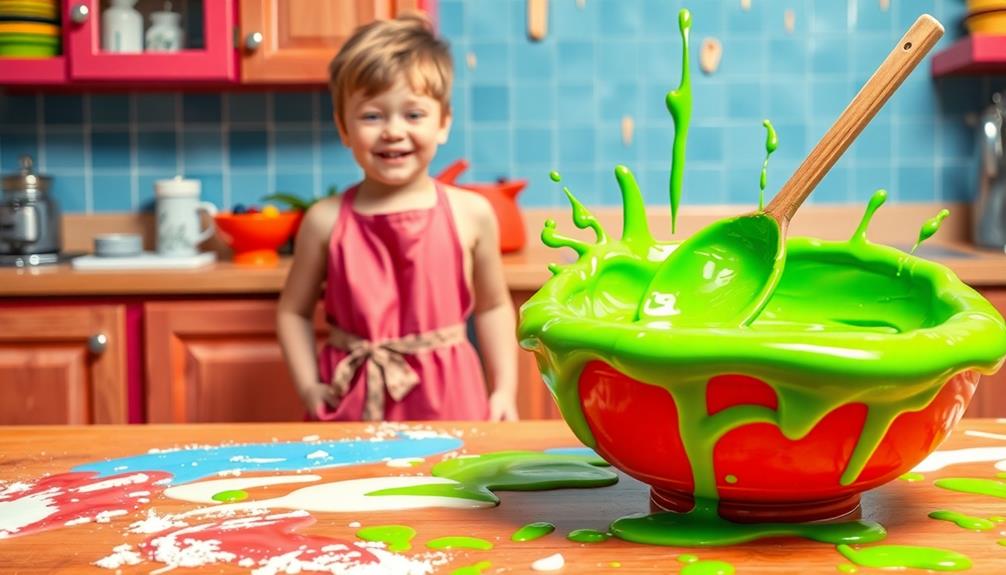
Making oobleck is super easy with just a few simple ingredients.
You'll start by mixing 1 ½ cups of cornstarch with 1 cup of water, adjusting as needed for the perfect consistency.
Let's walk through the step-by-step process to create this fun, non-Newtonian fluid!
[DIRECTIONS]:Simple Ingredients Required
To whip up a fun batch of oobleck, you'll need just a few simple ingredients: 1 ½ cups of cornstarch and 1 cup of water. This 2:1 ratio is key to achieving that perfect consistency. You can kick it up a notch by adding food coloring to make your oobleck visually exciting, but choose wisely to avoid any staining mishaps.
Here's what you'll need:
- 1 ½ cups of cornstarch – This is the main ingredient that gives oobleck its unique texture.
- 1 cup of water – Start with less to guarantee you can adjust the consistency.
- A large bowl or tray – Perfect for mixing without creating a mess during your fun sensory experience.
- Optional food coloring – This adds a splash of color and makes the oobleck even more engaging.
Make Oobleck is all about experimenting, so don't hesitate to adjust the water or cornstarch until you reach that delightful mix that flows like a liquid yet holds its shape like a solid.
Get ready for some hands-on fun!
Step-by-Step Mixing Process
Starting with the cornstarch, measure out 1 ½ cups and place it in a large bowl or tray. This is the base for your oobleck recipe.
Gradually add 1 cup of water to the cornstarch, using a spoon to stir and combine the ingredients evenly. Once mixed, immerse yourself and use your hands to knead the mixture. This helps achieve a cohesive texture.
If it feels too watery, add a bit more cornstarch to make it thicker; if it's too solid, add a splash more water.
After you reach the desired consistency, it's time to add some fun! Incorporate a few drops of food coloring to brighten your oobleck. Stir gently to distribute the color evenly throughout the mixture.
Keep experimenting with the texture until it feels solid when you squeeze it but flows like a liquid when you hold it loosely. This unique combination is perfect for kids to play with, offering a fascinating sensory experience.
Once you've perfected your oobleck, you'll have an exciting, gooey substance that's sure to entertain!
Understanding Oobleck Consistency
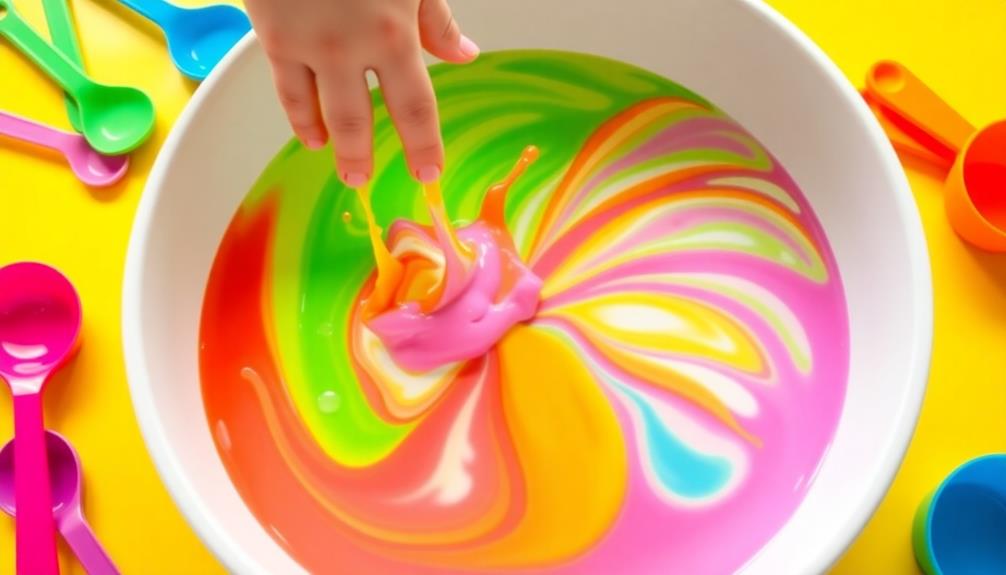
Understanding Oobleck consistency is key to creating the perfect playful substance for kids. This unique mixture behaves like a non-Newtonian fluid, meaning its consistency changes when you apply force.
When you poke it, it feels solid, but when it's at rest, it flows like a liquid. To get that ideal texture, aim for a consistency similar to honey or molasses. Here's how you can achieve that:
- Mix 2 parts cornstarch with 1 part water: For a balanced texture, use 1.5-2 cups of cornstarch and 1 cup of water.
- Adjust as needed: If it's too watery, add cornstarch by the tablespoon until it thickens; if it's too solid, incorporate water in small increments.
- Experiment with different ratios: Don't hesitate to tweak the mixture based on your preferences or environmental conditions.
- Observe how it behaves: Watch how it hardens under pressure but flows freely when you let it sit.
With these tips, you'll create the perfect oobleck for fun, hands-on play!
Creative Activities With Oobleck
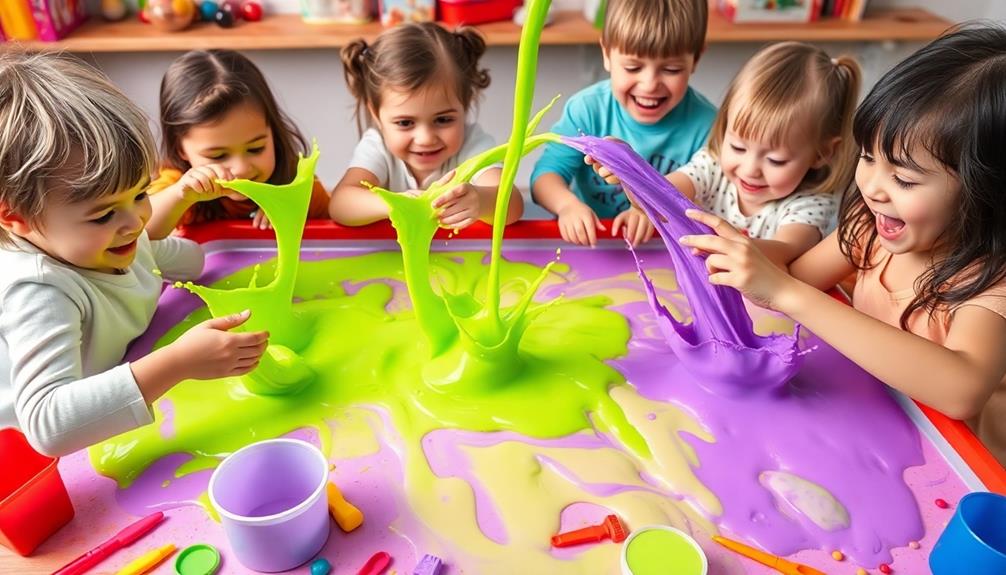
Oobleck isn't just a fascinating substance; it opens the door to a world of creative activities that spark imagination and curiosity in kids. You can make playtime even more fun by setting up a sensory bin filled with oobleck.
Drop in various plastic animals or vehicles and watch as they sink or float in this unique non-Newtonian fluid.
For a colorful twist, grab some food coloring and engage the kids in an oobleck painting activity. Pour the colored oobleck onto a canvas or paper, letting them swirl and spread it to create vibrant abstract art.
Want to explore science? Set up an oobleck volcano by mixing vinegar and baking soda with a bowl of oobleck. Kids will love observing the fizzing reaction and learning about chemical processes.
If you're looking to enhance gross motor skills, create an oobleck obstacle course. Challenge kids to walk across a shallow basin of oobleck while balancing objects on their heads.
Safety Tips for Oobleck Play

When kids immerse themselves in the fun of oobleck play, safety should always be a top priority. To guarantee a safe and enjoyable experience, here are some essential safety tips:
1. Supervise Children: Always keep an eye on the kids while they play with oobleck to prevent ingestion. While the ingredients are non-toxic, large quantities can be a choking hazard.
Additionally, just as you'd with an air purifier, guarantee that play areas are well-ventilated to prevent any buildup of moisture that could make surfaces slippery, similar to air quality considerations.
2. Protect Surfaces: Use a disposable tablecloth or newspaper underneath the play area. This makes it easier to clean up oobleck spills and protects your surfaces and clothing.
3. Prompt Cleanup: Quickly clean up any spills to avoid slipping hazards. Oobleck can become slippery when wet, so act fast to keep everyone safe.
4. Wash Hands: After playtime, guarantee that children wash their hands thoroughly to remove any residue and prevent accidental ingestion.
Storage and Disposal Methods
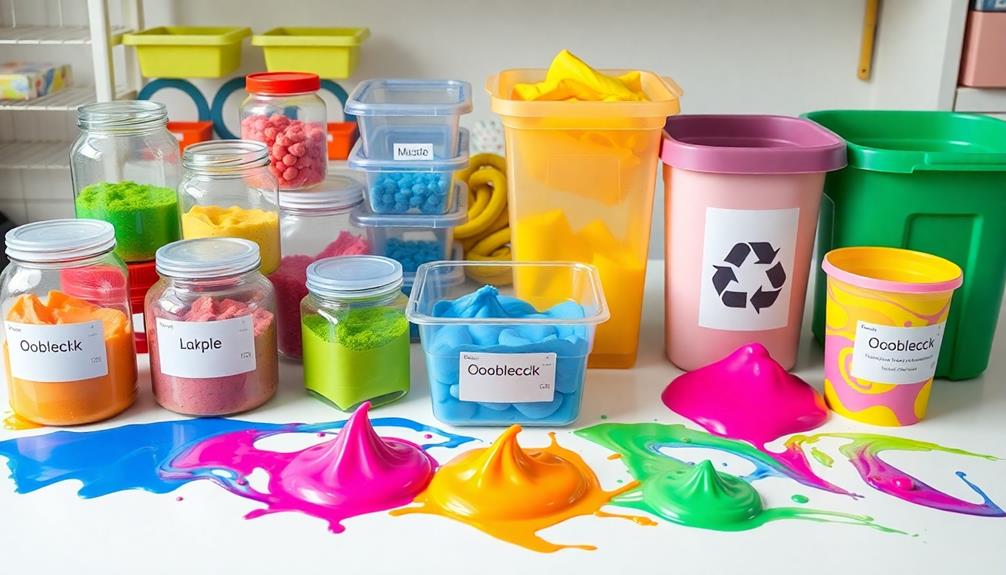
To keep your oobleck fresh and ready for fun, proper storage and disposal methods are key. Store your oobleck in an airtight plastic container to maintain its consistency and prevent mold growth for up to 24 hours.
If you notice the ingredients have separated during storage, don't worry—just stir the mixture to recombine it before use.
For long-term storage, let your oobleck dry out completely. When you're ready to play again, simply add water to restore its original texture.
Always check for any changes in texture or odor before using stored oobleck. If it seems spoiled or moldy, it's best to dispose of it.
When it comes to disposal, don't pour oobleck down the sink, as it can cause plumbing clogs. Instead, seal it in a plastic bag and throw it in the trash.
This guarantees a hassle-free cleanup without risking your plumbing. By following these storage and disposal methods, you can enjoy your fun oobleck without any worries!
Variations and Enhancements

After you've stored and disposed of your oobleck properly, it's time to get creative with it! You and your kids will love oobleck even more with these fun variations and enhancements:
- Glitter and Beads: Add some glitter or small beads to the oobleck for an engaging sensory experience. The sparkles and textures will captivate your little ones as they play.
- Rainbow Oobleck: Experiment with different food coloring combinations. Mixing colors can create vibrant, swirling patterns that are mesmerizing to watch.
- Scented Gelatin Powder: Incorporate scented gelatin powder into the mix. This adds a colorful and fragrant layer, making the experience even more delightful during playtime.
- Varied Textures: Adjust the cornstarch-to-water ratio for different textures. Thicker oobleck is perfect for sculpting, while a more liquid consistency is great for pouring activities.
You can even explore temperature variations by using warm water, creating a unique tactile experience as it cools during play.
With these enhancements, oobleck becomes an even more engaging activity that your kids will love!
Frequently Asked Questions
How Do You Make Oobleck Easy for Kids?
To make oobleck easy for kids, mix 1.5 cups of cornstarch with 1 cup of water in a large bowl. Let them use their hands to explore and adjust the consistency for a fun experience!
What Can Kids Do With Oobleck?
Imagine a magical substance that changes form at your touch. You can explore its solid-liquid dance, create colorful art, drop objects to discover their fate, or even ignite oobleck volcanoes for a thrilling, hands-on adventure!
How to Make Oobleck With 3 Ingredients?
To make oobleck, you'll mix 1 cup of cornstarch and ½ cup of water in a bowl. Add food coloring if you like, then adjust the consistency until it feels both liquid and solid. Enjoy!
How to Make Oobleck Busy Toddler?
To keep your busy toddler engaged, mix 1 cup of water with 1.5 cups of cornstarch. Adjust until it feels like honey, then add food coloring for extra fun while they explore its unique texture.
Conclusion
In the end, oobleck is more than just a colorful blob; it's a gateway to wonder and creativity. As your little ones plunge their hands into the gooey mixture, watch their eyes light up with curiosity, feeling the strange dance between liquid and solid. Each squish and splat invites exploration, sparking laughter and imagination. So, let the messy magic unfold—because in every playful moment with oobleck, you're not just making a mess; you're crafting unforgettable memories.

